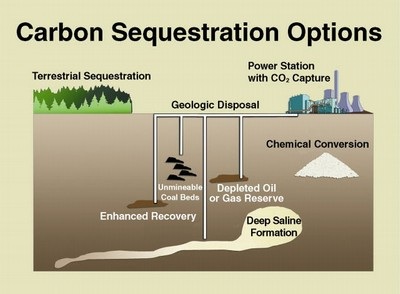By TIM FAULKNER/ecoRI News staff
 As the Green New Deal makes national
headlines, Sen. Sheldon Whitehouse, D-R.I., is advancing a less-heralded
approach to cutting climate emissions, one with the added benefit of removing
carbon dioxide from the atmosphere.
As the Green New Deal makes national
headlines, Sen. Sheldon Whitehouse, D-R.I., is advancing a less-heralded
approach to cutting climate emissions, one with the added benefit of removing
carbon dioxide from the atmosphere.
Whitehouse’s latest bill, the Utilizing Significant Emissions
with Innovative Technologies Act (USE IT Act) offers $50 million in
financial incentives for carbon-capture research and infrastructure for a range
of technologies, such as innovative systems that take carbon dioxide out of the
atmosphere and smokestacks.
“The science from the world’s top experts, including our own National Academies, shows that we ought to be reversing the carbon pollution driving climate change. If we don’t, it will be nearly impossible to avoid the worst of climate change,” Whitehouse wrote in a press release.
Carbon capture, sometimes referred to as
negative emissions technologies, has been lumped with less-proven methods such
as bioengineering and artificial manipulation of the weather to slow the
heating of the atmosphere.
But, unlike bioengineering, several
carbon-capture systems are functioning on a small scale and simply need market
incentives to make them enticing to polluters.
Captured carbon dioxide is stored underground or used for carbonating beverages. It also feeds algae and is sequestered in raw materials for making plastics, chemicals, cement, and biofuels.
Captured carbon dioxide is stored underground or used for carbonating beverages. It also feeds algae and is sequestered in raw materials for making plastics, chemicals, cement, and biofuels.
Many academics and climate groups,
including the U.N. Intergovernmental Panel on Climate Change, support
carbon-capture technologies but worry about perfecting and scaling these systems
in time to keep the planet from exceeding a 1.5 degree Celsius rise in
temperature.
Some environmental groups such as the National Resources Defense Council oppose subsidies for carbon capture because they see it as supporting fossil-fuel extraction, particularly for the process of pumping CO2 into wells to withdraw residue oil reserves, called enhanced oil recovery.
Some environmental groups such as the National Resources Defense Council oppose subsidies for carbon capture because they see it as supporting fossil-fuel extraction, particularly for the process of pumping CO2 into wells to withdraw residue oil reserves, called enhanced oil recovery.
Big carbon emitters, such as oil and
natural-gas extraction companies, aren’t enthusiastic about backing the
potential of carbon capture.
“I would like to say they are
helpful but I can’t,” Whitehouse said.
Companies such as ExxonMobil,
Whitehouse said, feign support for carbon capture so they can tell shareholders
they are taking on climate change. But the pledge is simply a red herring that
gives justification for the extraction and drilling of fossil fuels for
decades, according to Whitehouse.
“I would have to say that the
fossil-fuel industry is still trying to deny the problem and shut down any and
all political solutions,” he said. “They don't seem to have a long-term plan.”
But there is support for carbon
capture among coal-mining states. Removing carbon from coal emissions gives
hope to an embattled industry and creates rare bipartisan action during a time
of political stalemate.
The USE IT Act is co-sponsored by Sen. John Barrasso, R-Wyo., and endorsed by senators Shelley Moore Capito, R-W.Va., Tom Carper D-Del., Tammy Duckworth, D-Ill., Kevin Cramer, R-N.D., Tina Smith, D-Minn., Joe Manchin, D-W.Va., and Mike Enzi, R-Wyo.
The USE IT Act is co-sponsored by Sen. John Barrasso, R-Wyo., and endorsed by senators Shelley Moore Capito, R-W.Va., Tom Carper D-Del., Tammy Duckworth, D-Ill., Kevin Cramer, R-N.D., Tina Smith, D-Minn., Joe Manchin, D-W.Va., and Mike Enzi, R-Wyo.
The bill comes a year after
Whitehouse scored a win with passage of a carbon-capture bill last year. The FUTURE Act extended
and increased tax credits for carbon-capture technologies, helping companies
such as Agcore Technologies LLC of
Cranston, which grows high-protein algae used in foods.
The USE IT Act goes further by
increasing funding for infrastructure, such as pipelines for direct air capture
systems. These facilities are being developed by BioProcessH20
of Portsmouth, Enhanced Energy Group
of West Kingston and Global Thermostat of
New York City.
The money will help scale up
development of existing carbon-capture systems, like the one at a coal power plant in
Saskatchewan. And carbon capture startups
backed by inventors like Bill Gates will get a boost.
This funding helps these companies
get closer to profitability. And coupled with a carbon fee program, or carbon
tax, emitters of greenhouse gases will be more inclined to see carbon capture
as a way to remove and reuse their excess CO2 and save money.
The USE IT Act is supported by
environmental groups such as The Nature Conservancy, Clean Air Task Force, and
the Audubon Society.
“We need both carbon capture on
smokestacks and carbon removal from the atmosphere if we are going to prevent
the worst impacts of climate change,” said Armond Cohen, executive director of
the Clean
Air Task Force.
“Adoption by Congress of the USE IT Act would encourage early stage innovation for carbon removal and help develop needed infrastructure for both technologies.”,
“Adoption by Congress of the USE IT Act would encourage early stage innovation for carbon removal and help develop needed infrastructure for both technologies.”,